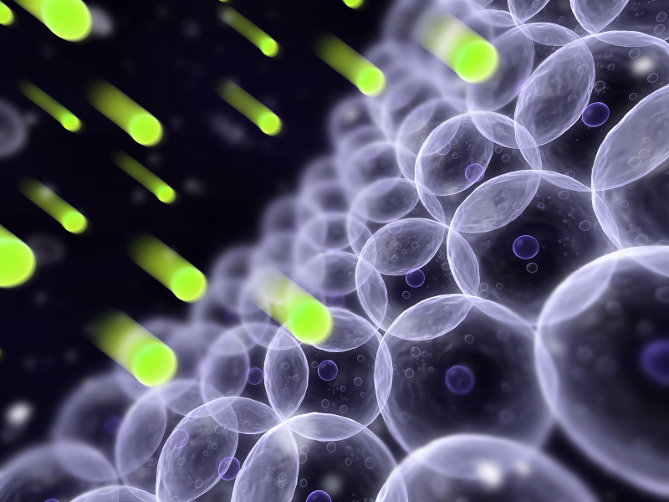How Free Radicals Age Skin
What Are Free Radicals?
Free radicals are atoms or molecules with unpaired electrons. They are extremely reactive and attack whatever lies in their path: proteins such as collagen and elastin, epidermal lipids, cell membrane lipids, mitochondria, other cellular organelles, and worst of all, DNA.
One of three things can happen when a free radical attacks a cell:
- The cell becomes damaged or dysfunctional
- The cell becomes cancerous
- The cell dies
The Free Radical Theory of Aging
Free radicals are one of the main mechanisms of the aging process.
The gist of this theory is that free radicals attack essential components of cells. These cells become damaged (known as oxidative damage).
When the damage cannot be repaired, the cells become dysfunctional or they die.
Why Is DNA Damage So Bad?
DNA is the vital genetic code that guides every process in the body. It dictates what proteins get made (proteins run everything).
DNA is located in two places inside a cell, the
nucleus and
mitochondria.
Certain free radicals are able to reach the nucleus or mitochondria (see Reactive Oxygen Species). Those are the most destructive ones. When the DNA is attacked by these free radicals, mutations can form.
Most of the time, a cell is able to repair DNA damage. But as the cell ages, it becomes less efficient at repair. If the attack is acute, the repair doesn’t happen and the cell dies through self-inflicted cell suicide (called apoptosis).
When Are Free Radicals Generated?
There are many sources of free radicals – external and internal. The biggest external source is UV radiation. Internally, it’s the process of digestion and breathing.
During Sun Exposure
UV radiation, whether from sun or a tanning bed, is a major trigger of free radicals. When UV light contacts skin, it reacts with oxygen from the air, which causes a destructive, long-lasting free radical chain reaction.
Sun + Oxygen + Skin –>
Nasty Free Radical Chain Reaction in Skin –>
DNA/Protein/Membrane Damage or Cell Death –>
SKIN AGES!
During Digestion & While Breathing
Free radicals are generated in the normal course of metabolism. In other words, whenever we consume food, which is then digested to produce energy. The process of digestion creates free radicals!
Free radicals are also created when we breathe! Why do digestion and breathing create free radicals? Because both involve OXYGEN. The oxygen we breathe is carried into cells via the blood, and 99% of it is used to produce energy that we need (the biochemical term for that energy is ATP). This is normal oxygen. It is not reactive.
But the remaining 1% of that oxygen enters into a free radical reaction and causes a great deal of destruction everywhere in the body. This kind of oxygen is called Reactive Oxygen Species, which are very harmful types of radicals.
How ironic that oxygen is essential to life but at the same time toxic. As long as we breathe and eat, we will sustain free radical damage. It is a lifelong assault that begins at birth and ends at death. This is why we can’t stop aging. We can only slow it down.
Note: Reactive Oxygen Species is covered in a separate article to keep things simple here. I recommend reading it if you are highly invested in skin care or pay close attention to ingredients because it is such an important concept in aging. Reactive Oxygen Species can be targeted by different ingredients.
Sources of Free Radicals
Breathing and digestion are internal sources. External sources include:
- UV radiation
- Xrays
- Air pollution / smog
- Cigarette smoke
- Alcohol
- Ozone
- Heavy metals
- Rancid fats
- Drugs
- Hormones
- and more
Oxidative Stress (Damage)
An excessive amount of free radicals creates oxidative stress on the body, overwhelming the body’s antioxidant defense system. The result is tissue damage.
“Oxidative” means related to oxygen. So oxidative damage means damage caused by oxidation.
A simple analogy is a freshly cut apple that has turned brown. When the apple is exposed to air, it oxidizes. The brown color is a sign that it has undergone oxidation.
What Is the Effect of Free Radicals on Skin?
Free radicals damage, weaken, or destroy connective tissue, such as collagen and elastin in skin. They can travel throughout the different layers of skin. UV, for example, can penetrate deep into the dermis where most of collagen lies.
How Can Free Radicals Be Defeated?
The first line of defense against free radicals is minimizing exposure to them in the first place. Protecting skin from the sun, smoke, and pollution are activities within our control.
The second line of defense is antioxidants and antioxidant enzymes. Antioxidants neutralize the free radicals and interrupt the free radical chain reaction before they can cause too much harm.
The third is assisting cells in repairing damaged DNA. This is a hot area in ingredient research right now.

